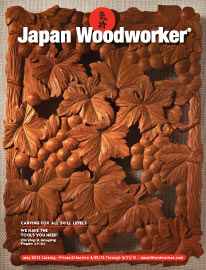Interview with a Japanese Dai (plane body) MakerIt's said that to make a plane Dai (Japanese Plane Body) is difficult, but Dai makers feel very happy at the moment when a plane shaves wood well as the shavings come out of the plane. Mr. Inomoto who has made Dai for 55 years says to visitors to his plane Dojo, "You should realize the importance of this pleasant feeling." In Sanjo, Niigata, cutlery and hand tools have been made for a long time. There are still wholesalers who sell carpenter tools and so on. Dai makers mainly receive orders from them. Each plane blade is slightly different even if the same plane maker makes the blade and the thickness and the curve look the same. A Dai is made for each plane blade and there is no substitute. Artisans say, "A blade maker plays a leading role and a Dai maker plays a supporting role." But it has also been said for a long time that a Dai is 70% and a plane blade is 30%. This shows how important the Dai is. Mr. Isao Inomono, a Dai maker, is currently making a Dai for a jointer plane. It's called NagaDai and about 390mm (15") long. Furniture makers use it to smooth drawers. If the plane is used for wood like Japanese cedar and pine, the plane blade should be set at about 38 degree. If it's used for hard wood like zelkova trees, the plane blade should be set at 40 - 42 degrees. If it's used for soft wood like paulownia, the plane blade should be set at about 31 degrees. He measures with a square and marks a line on a Dai with ink. Then he chisels a rough mortise which has a gradual slope. This can be done only by hand. The ink line on the Dai actually isn't very useful. He knows the angle of the slope by using the skill he has learned after practicing for a life time. He sets a plane blade dipped in oil in to the mortise and checks the slope. This is the most important process of making a Dai. You can't plane well if a plane blade doesn't fit a Dai. Even if the plane blade is very sharp, the plane doesn't work well. He continues to set the plane blade, chiseling slightly as he decides the best angle. A plane blade is driven into the mortise of a Dai just like a wedge. That's why viscous oak wood is used for a Dai. If the wood is only hard, the Dai is easy to split. There is material for about 30,000 - 40,000 Dai on the second floor of his workshop. After the wood was cut down in winter and sawed up into logs, it is dried there for 3 or 4 years before using. Mr. Inomoto planes and smoothes the back of the sole. Because, if the back is level with the front, the user cannot pull the plane well. He must shave off the sole from the mortise opening of the Dai to the back end. Because of tension when the blade is driven home, the back becomes level and the user can pull the plane well. He uses small Tachi Kanna for this purpose. A blade of the Tachi Kannna stands vertical. "I've used this Tachi Kanna for longer than 40 years." It's made from white oak but it turned black. "It's only Dai makers who make planes by using planes they make themselves." After setting a blade in a Dai, he immediately makes a trial cut. The plane shaves wood very smoothly and the shaving is very thin. The surface of the wood is really smooth. Because cells of the wood were cut perfectly, the surface doesn't absorb water. If a carpenter planes wood well, the wood is smooth and durable. Mr. Inomoto sometimes delivers his planes with shavings to his customers. The shavings show good sharpness. "Some carpenters call the shavings a shaved flower." It means the shavings aren't waste but a flower that is come up from a good plane. This shows enthusiasm of both artisans of making and using planes. Mr. Inomoto's teacher established the workshop in 1937. He started to help his teacher with making planes when he was in junior high-school. He couldn't chisel a mortise well enough, so he chiseled roughly every day. He finally could make a plane at the age of 15. In 1972 Mr. Inomoto married Ms. Tsuyako Inomoto who lived in the neighborhood. They continue to work together in the workshop. He has three daughters and a granddaughter. The granddaughter often visits his workshop and imitates him. He laughs and says, "My granddaughter will perhaps become my successor. Mr. Inomoto hung out a signboard that reads a plane Dojo in front of the workshop. If he's asked by young Dai makers, he's willing to teach them the skill he's practiced for 55 years. He accepts only the cost of materials for a plane and doesn't receive tuition fees. He isn't thinking of training Dai makers but would like visitors who are interested in making planes to learn new skills casually. He believes this is better than concealing his skills.
Comments (0)
|
 Click Here to View Catalog
Click Here to View Catalog